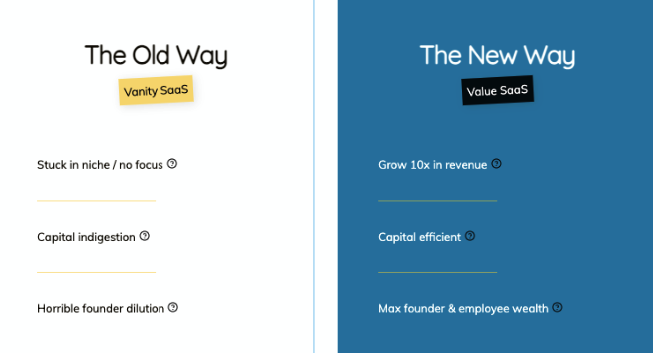A step-by-step method to build a story that pulls the audience

Have you ever tried to move a lawn mower?
It isn’t easy. Friction can be a real pain in the butt.
You can move the lawn mover in two ways. You could either move it towards you or… you could move it away from you. Which one would you choose?
Physics tells us that the answer is the former. Friction is lesser when you move the lawn-mover towards you. In other words, pulling is better than pushing.
A great brand story pulls the right people
Instead of pushing our marketing message down their throat, we can pull the right audience towards us. A great story cuts through the noise and gets the attention of the audience. It inspires them. It moves them from inertia. And pulling eventually leads to more profits and better impact.
The story empowers all the teams in the organization. Sales becomes easier. Paid campaigns show a better ROAS. Your social media lights up.
“No one ever made a decision because of a number. They need a story.” – Daniel Kahneman
Should you create a story before the product?
In an ideal world, the brand narrative should be created even before the product is launched. While many businesses and Creators do follow this path, there are others who create a story after the product is launched. Both the approaches work just fine.
How to create a brand story
The process is pretty straightforward. We create a brand story by defining an old game that we can attack and by proposing a new game instead. Sounds a little confusing? Stick around, it only gets easier. Let’s talk about the specific steps for creating the ‘old game’ and the ‘new game’ for your brand
Step 1: Gather the frustrations
The ‘old game’ is what frustrates your audience. The old game talks about everything that is wrong in this world… everything that is holding your audience back. So take everything that is ‘bad’ and put it in this box.
Step 2: Naming the old game
Give this ‘old game’ a name.
Step 3: Gather the things that they should be doing instead
While you are asking the audience to abandon the old game, you also need to define the new game for them. Make a list of all the things that your customers should be doing. Put it in a box. This list is the opposite of the old game.
In the old game if you mentioned “You should work out in the gym even if you don’t like it”, the new game should mention “Make work-outs fun”.
Step 4: Name the new game
Give this ‘new game’ a name.
The old game is the enemy. The new game is what you stand for. And your brand helps your audience move from the old game to the new game.
Vanity Saas and Value Saas
‘Upekkha’ is an incubator that helps Saas brands scale from $100k ARR to $10 million ARR. The old game that they defined was ‘Vanity Saas’ and the new game that they teach is ‘Value Saas’.
According to the founders, ‘Vanity SaaS’ mindset chases vanity metrics of business building and usually requires $5 of investment for creating $1 in revenue. This approach of ‘Go big or Go home’ has given zero returns to more than 85% of founders who have burnt years of their life, only to realize that majority of the returns are captured by investors that promote such a vanity mindset.
In the Value SaaS model, founders create highly valuable outcomes for all stakeholders – customers, employees, investors, and themselves because they are in control of their business.
This is a screenshot from Upekkha’s old website –

As you can see, Upekkha has done a brilliant job of defining and naming both games. You can check out their current website here and the old website here.
Hourly Billing is nuts
Traditional wisdom suggests that Consultants and freelancers should charge by the hour. ‘Hourly billing’ is simple. If you work for an hour, you get paid X dollars. If you work for 2 hours, then you got $ 2x. 3 hours get you $ 3x… and so on. According to Jonathan, this pricing strategy has a lot of flaws. ‘Hourly billing’ is harmful to both – the consultants and the clients. A better way is to have ‘Value Pricing’.
Check out Jonathan’s detailed story here.

Isn’t a brand story risky?
It’s clear that with your ‘New Game’ you will be alienating the audience that wants to keep clinging to the old game. You will not appeal to them. You will offend them. You will push them away.
And that’s okay.
You don’t need everyone to be your customer.
“Pick the smallest viable audience that you can serve”. – Seth Godin.
Because of its polarizing nature, the story might repel a part of your audience, but this polarizing nature itself will ensure that it strongly resonates with the audience that you actually want to serve.
So, don’t be afraid. Be opinionated. Be polarizing.
A brand story can evolve
Perfectionism can creep in and we can get into an over-thinking rut. At times, Brand story A seems nice. But on other days, Brand story B feels right. It’s absolutely okay to have these doubts. Just know that nothing is etched in stone. Story building is an iterative process, especially if the brand is young. You are allowed to pivot. You are allowed to see what resonates and then change your brand story based on that.
To summarize
A great story attracts the right people to your brand. Use the old game and the new game to build this story. And the next time your lawn is dirty, please don’t try to push the lawn-mover. Instead…
P.S. If you are interested in learning more about using the power of storytelling to get the growth for your brand, subscribe to my weekly newsletter.
Credit where it’s due. A lot of these ideas were inspired by Louis Grenier and Andy Raskin. Thanks guys. 🙂

Have you ever tried to move a lawn mower?
It isn’t easy. Friction can be a real pain in the butt.
You can move the lawn mover in two ways. You could either move it towards you or… you could move it away from you. Which one would you choose?
Physics tells us that the answer is the former. Friction is lesser when you move the lawn-mover towards you. In other words, pulling is better than pushing.
A great brand story pulls the right people
Instead of pushing our marketing message down their throat, we can pull the right audience towards us. A great story cuts through the noise and gets the attention of the audience. It inspires them. It moves them from inertia. And pulling eventually leads to more profits and better impact.
The story empowers all the teams in the organization. Sales becomes easier. Paid campaigns show a better ROAS. Your social media lights up.
“No one ever made a decision because of a number. They need a story.” – Daniel Kahneman
Should you create a story before the product?
In an ideal world, the brand narrative should be created even before the product is launched. While many businesses and Creators do follow this path, there are others who create a story after the product is launched. Both the approaches work just fine.
How to create a brand story
The process is pretty straightforward. We create a brand story by defining an old game that we can attack and by proposing a new game instead. Sounds a little confusing? Stick around, it only gets easier. Let’s talk about the specific steps for creating the ‘old game’ and the ‘new game’ for your brand
Step 1: Gather the frustrations
The ‘old game’ is what frustrates your audience. The old game talks about everything that is wrong in this world… everything that is holding your audience back. So take everything that is ‘bad’ and put it in this box.
Step 2: Naming the old game
Give this ‘old game’ a name.
Step 3: Gather the things that they should be doing instead
While you are asking the audience to abandon the old game, you also need to define the new game for them. Make a list of all the things that your customers should be doing. Put it in a box. This list is the opposite of the old game.
In the old game if you mentioned “You should work out in the gym even if you don’t like it”, the new game should mention “Make work-outs fun”.
Step 4: Name the new game
Give this ‘new game’ a name.
The old game is the enemy. The new game is what you stand for. And your brand helps your audience move from the old game to the new game.
Vanity Saas and Value Saas
‘Upekkha’ is an incubator that helps Saas brands scale from $100k ARR to $10 million ARR. The old game that they defined was ‘Vanity Saas’ and the new game that they teach is ‘Value Saas’.
According to the founders, ‘Vanity SaaS’ mindset chases vanity metrics of business building and usually requires $5 of investment for creating $1 in revenue. This approach of ‘Go big or Go home’ has given zero returns to more than 85% of founders who have burnt years of their life, only to realize that majority of the returns are captured by investors that promote such a vanity mindset.
In the Value SaaS model, founders create highly valuable outcomes for all stakeholders – customers, employees, investors, and themselves because they are in control of their business.
This is a screenshot from Upekkha’s old website –

As you can see, Upekkha has done a brilliant job of defining and naming both games. You can check out their current website here and the old website here.
Hourly Billing is nuts
Traditional wisdom suggests that Consultants and freelancers should charge by the hour. ‘Hourly billing’ is simple. If you work for an hour, you get paid X dollars. If you work for 2 hours, then you got $ 2x. 3 hours get you $ 3x… and so on. According to Jonathan, this pricing strategy has a lot of flaws. ‘Hourly billing’ is harmful to both – the consultants and the clients. A better way is to have ‘Value Pricing’.
Check out Jonathan’s detailed story here.

Isn’t a brand story risky?
It’s clear that with your ‘New Game’ you will be alienating the audience that wants to keep clinging to the old game. You will not appeal to them. You will offend them. You will push them away.
And that’s okay.
You don’t need everyone to be your customer.
“Pick the smallest viable audience that you can serve”. – Seth Godin.
Because of its polarizing nature, the story might repel a part of your audience, but this polarizing nature itself will ensure that it strongly resonates with the audience that you actually want to serve.
So, don’t be afraid. Be opinionated. Be polarizing.
A brand story can evolve
Perfectionism can creep in and we can get into an over-thinking rut. At times, Brand story A seems nice. But on other days, Brand story B feels right. It’s absolutely okay to have these doubts. Just know that nothing is etched in stone. Story building is an iterative process, especially if the brand is young. You are allowed to pivot. You are allowed to see what resonates and then change your brand story based on that.
To summarize
A great story attracts the right people to your brand. Use the old game and the new game to build this story. And the next time your lawn is dirty, please don’t try to push the lawn-mover. Instead…
P.S. If you are interested in learning more about using the power of storytelling to get the growth for your brand, subscribe to my weekly newsletter.
Credit where it’s due. A lot of these ideas were inspired by Louis Grenier and Andy Raskin. Thanks guys. 🙂
